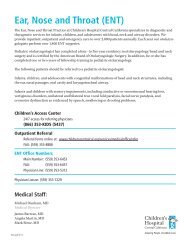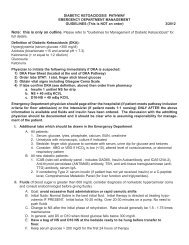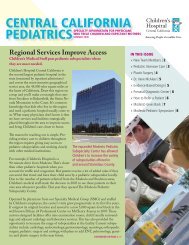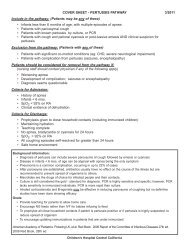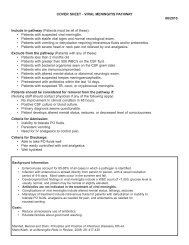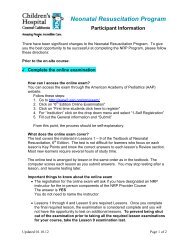Possibilities - Children's Hospital Central California
Possibilities - Children's Hospital Central California
Possibilities - Children's Hospital Central California
Create successful ePaper yourself
Turn your PDF publications into a flip-book with our unique Google optimized e-Paper software.
Sereykunthea Ry’s symptoms had herall tied up in knots.The 13-year-old Fresno girl took a turn for theworse when she developed flu-like symptoms, fever,chills and stomach-aches, as well as an abscess onher neck.“I was at home playing and my stomach startedhurting,” says the teenager. “A few weeks later therewas a bump on my neck.”On doctor’s orders, it was off to Children’s <strong>Hospital</strong><strong>Central</strong> <strong>California</strong>. The teenager was admitted andInfectious Disease physician Dr. James McCartyhad x-rays performed, revealing inflammation in herchest as well as an infection in her throat.The family’s world was twisted and turned upsidedown at the news of their daughter’s illness. “I justwanted to make sure she was OK,” says her mother,Savoeun. “At Children’s <strong>Hospital</strong>, I knew she was ingood hands, I wasn’t worried at all. They really tookgood care of her.”The disease usually causes flu-like symptoms andcan sometimes affect the lungs. Some may developa serious or even fatal illness such as severe lungdisease requiring hospitalization. A small percentageof those infected can develop chronic Valley Feverthat spreads outside the lungs to the brain, bone andskin. Without proper treatment, it can lead to severepneumonia, meningitis and even death.The young patient finally took a turn for the betterafter more than two weeks of care at Children’s.Dr. McCarty and staff aggressively attacked theA Twist of FateThe Players: Dr. James McCarty and the Infectious Disease Practice at Children’sDr. McCarty and his team in the Infectious DiseasePractice took culture samples and diagnosedSereykunthea with Valley Fever. Valley Fever iscaused by a fungus that grows naturally in soil in thesouthwestern U.S. and produces spores that can beinhaled when they get into the air.illness with doses of antifungal medications to killthe fungus and treat the underlying infection.Sereykunthea’s father, Bo, frequently visited and hermom stayed at her bedside until she started gettingbetter. Then the teenager’s mother would go homeand cook her daughter’s favorites – rice, chicken andsoup – and bring them back for her to eat.“Dr. McCarty and the nurses are very caring, theyshow emotionally that they care,” says her mother.“Dr. McCarty came and talked to her when she wassad. When they see that children are sad they willcheer them up and raise their spirits.”Back on her feet again, she headed home wherebrothers Ratha, Chetha, Somta, Sinty and her dogTickle anxiously awaited.Sponsored byJames & Barbara Meinertand FamilyThe teenager’s life is anything but ordinary nowthat she has to adjust to the special challengesassociated with her condition, such as the antifungalmedication she continues to receive at Children’sthree times a week. But her condition is treatableand she won’t have the disease for a lifetime, andthat’s a great twist at the end of the story.Photo SponsorKathleeen L. Behr, M.D.Dermatologic Surgeon



